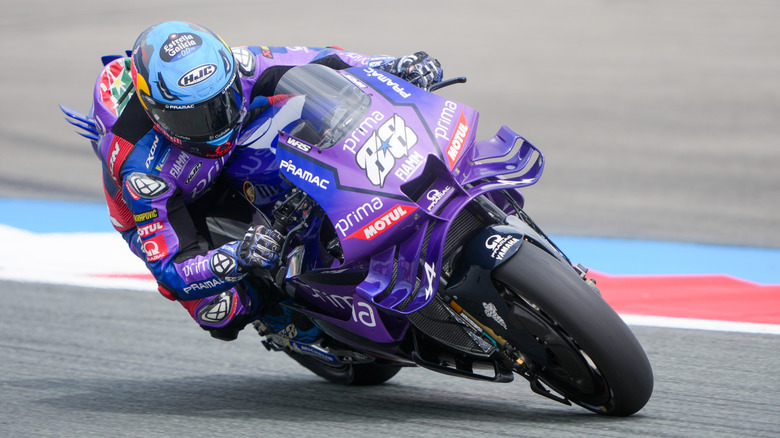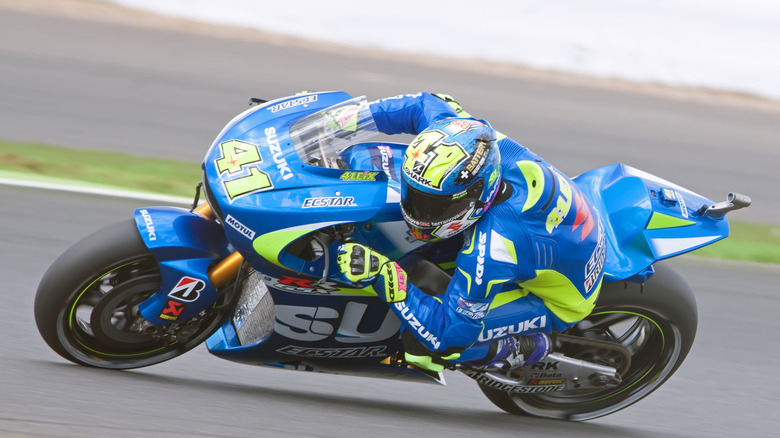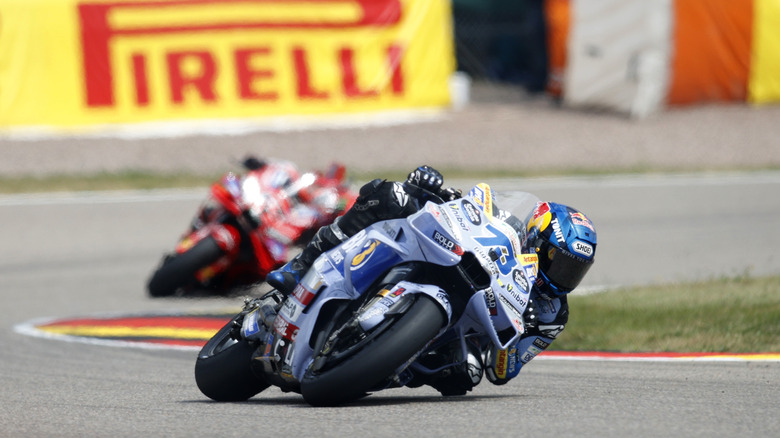
Grand Prix motorcycle racing, commonly referred to as MotoGP, is — much like F1 — having a moment. There appears to be a wave of excitement crashing over the sport, bringing new fans into the fold and keeping current enthusiasts enthralled. The sport offers a lot to geek out on, with strategy and game plans devised by teams pre-race, down to the engineering marvels of the bikes, and, of course, the talent of the riders themselves. Even the most insignificant-seeming tactics make a difference. You
may have wondered why some MotoGP riders tape their noses, which has to do with improving airflow and breathing during intense races, or why they stick their legs out when braking, a technique that has both aerodynamic and psychological benefits.
Over the years, MotoGP continues to get safer and safer, where it was once considered a pretty high-risk sport. Back in the day, a rider's only hope of surviving a crash was their leather suits and not hitting any obstacles. Advances in technology and pushing for more stringent safety precautions led the organization behind the Grand Prix to adopt — and enforce — the use of airbag systems to protect riders since 2018. These suit-integrated airbag systems are equipped with an array of flashing lights, all of which function to alert both riders and support teams with corresponding signals. The issue of visibility and signalling is of the utmost importance to any motorcyclist — whether on a track or public road — to ensure rider collisions are avoided.
Read more: 6 Of The Fastest Cruiser Motorcycles, Ranked By Top Speed
The Tech Behind MotoGP Suits

In recent years, MotoGP riders wear suits filled with airbags that are automatically deployed during crashes, helping to protect a rider's rib cage, shoulders, neck, and back. When fully inflated, they almost resemble oversized shoulder pads used in the NFL, enabling drivers to walk away from brutal spills. The suits have flashing LED systems integrated into them, which signal in real time the airbag status, showing if it's armed, active, or if it's been deployed. The Alpinestars Tech-Air 5 airbag system, used by some riders, has integrated LED lights that continually run self-diagnostic checks and signal "all clear" once the suit is ready for racing.
Like any sport, the equipment continues to evolve, and MotoGP is no different. From only wearing thin layers of leather back in the day, to now, where, as an example, the hump at the rear of a suit stores hydration systems, cooling ducts, and the mechanical and electronic components for the airbag system — something that would have been unimaginable decades past. These modern safety systems, body armor, and helmets adorned by current MotoGP riders make the older gear look primitive by comparison. Cutting-edge tech like "viscoelastic-foam soft armor" is being explored by racing gear manufacturers who, in the interest of rider safety and comfort, further seek to optimize the equipment of the sport.
The Future Of MotoGP Tech

It's in everyone's best interests to continue to make MotoGP safer, which, ultimately, means more enjoyment for fans and teams alike. And while the sport is inherently dangerous, both teams and engineers are incentivized to make it safe while keeping it exciting. As the technology advances, it might not be so far-fetched to imagine the motorcycles themselves having airbags built into them, further protecting riders during collisions. Whether this is feasible for MotoGP remains to be seen, but the technology has already been considered for civilian bikes by manufacturers like Yamaha. According to the NHTSA, from 1987 to 2017, 50,000 Americans alone would have suffered fatal injuries had airbags not been deployed in cars. But in motorcycles, on-board airbag systems are still very much in beta stages, save for a few examples like the massive Honda Gold Wing cruiser.
Other examples of where the sport's safety technology could go are airbag pants, which would inflate on impact, to protect the lower body — especially the legs and hips — from grave injury, as this region of the body suffers the most upon impact in motorcycle accidents. If these types of systems could be worn by MotoGP riders without impeding aerodynamics, they could conceivably become standard — perhaps unthinkable now, like the current LED systems were to fans and riders of yesteryear. And if motorcycle manufacturers can implement some of the safety measures from MotoGP into civilian bikes, this cross-pollination of tech could help even more people.
Want the latest in tech and auto trends? Subscribe to our free newsletter for the latest headlines, expert guides, and how-to tips, one email at a time.
Read the original article on SlashGear.











